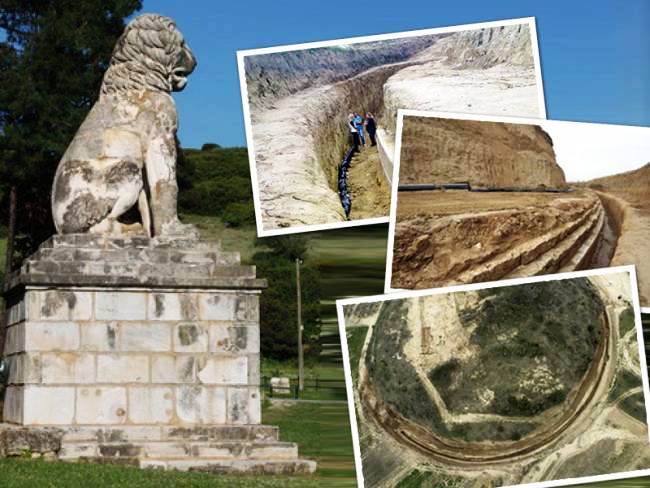
Marina Schiza asked me to write a short critique about Amphipolis for Phileleftheros, and I did so yesterday. I am not sure when the piece will appear, but it was very easy for me to be critical of the many jealous colleagues whose envy of Dr Peristeri's discovery is eating away at them. I will not repeat what I wrote there, but elaborate on the good work at Amphipolis instead.
Envy is a universal quality too many people suffer from, and over the years I have been repeatedly shocked by how badly some archaeologists behave, in Britain, Denmark, America and almost every country, not just in Greece. I should note that those tend to be the mediocre scholars, envious of those who have skill and talent, mediocrities who try to diminished the work of good archaeologists because they cannot reach such heights themselves.
I do not know Dr Peristeri very well, but her work is of an extremely high caliber. I have known her dig's architect for many years, and he is also one of the most talented people working for the archaeological service (someone from one of the most prestigious American universities asked me last year if I thought he could be lured away from Greece, that is how good his work is). I am not sure which technicians are currently on the dig at Amphipolis, but I was blown away by the amazing work the restorers and technicians working on the slopes of the Acropolis were doing, and their current standard of work is far superior to anything I have seen in Italy, Turkey, Egypt any many other countries. The Chinese have been making remarkable progress in terms of new techniques for preserving archaeological discoveries, for example lacquer found in water-logged tombs, and Greece in my opinion is currently second only to them.
That is why I found it shocking that Dr Peristeri had to defend her work: Υπουργείο Πολιτισμού και Αθλητισμού - Απάντηση της κ. Κατερίνας Περιστέρη
I generally have avoided reading coverage other than the press releases, because I did not feel the need to read foolish opinions claiming the tomb was Roman, and ridiculous attacks on the techniques used, attacks founded in fantasy not reality as here: Σάλος για την Αμφίπολη-Νακάσης: ?Δεν έγινε σωστά η ανασκαφή, υπάρχουν κι άλλοι τάφοι?
To make it very clear, the team at Amphipolis were not leaking information to me, because they did not need to. They are great archaeologists, and all good archaeologists work in more or less the same way, so it is very easy for me to "read" what they doing and sometimes even thinking of doing next based purely on the photographs and information they release.
The partially excavated mosaic? Yes I think Hades was shown with the features of Philip II, but there was a female arm showing in the first set of photographs, so it was almost certain that the female figure to the right when unearthed would be Persephone.
Do I wish they'd have a little more time to proceed a little more slowly, most of all so that they could have days of rest? Yes. But were they working badly? No.
The soil fill was obviously all of one date, so the small finds within it would have been plotted and recorded, but there was no need for slow excavation ... it was all one 'strata' or layer of fill, so slowly sweeping away the soil with a brush would have been a ridiculous thing to do. Also tightly packed soil in a closed chamber is impossible to fully sift through inside the tomb, so the soil was bagged up and taken away to be examined by other members of the team in an environment where they would not only have the space to do so, but also the equipment they needed.
Where different techniques were needed, they used them. For example under the blocks in the last room, based on this photograph the various 'strata' or layers are extremely clear. I have marked alternate strata with red arrows, and the yellowish layer which I assume is the clay with a green arrow:
The stratigraphy is so clear it can be read in photographs, and there are very few other excavations where this is the case. And this photo was only intended to be a general view of where the door was found, not a photograph of the stratigraphic evidence!
To me one of the great joys of Amphipolis is how much interest it has renewed in Greek history and archaeology, with people reading academic articles that would normally only reach a small audience, and discussing them as they form new ideas.
We all have the right to an opinion. I have mine. I disagreed with Olga Palagia's, but she has the right to express hers, and ideas one disagrees with can push us into better formulating and explaining one's own. Athanasios Nakasis had the right to his opinions as well. The problem is that he clearly demonstrated that the failure to understand modern archaeological techniques was his, and not made by the team at Amphipolis. In English we call that a Pyrrhic Victory.
I love archaeology and part of my nature is that I love sharing it by trying to explain it to people, and encouraging them to think for themselves about it. But it worries me that several Greek archaeologists, who are teaching Greek students and excavating Greek archaeological sites, seem to be demonstrating so little understanding of the field.
Katerina Peristeri is leading a team doing exemplary work on one of the most important discoveries in archaeology. No amount of ridiculous claims can diminish her, her find or its place in history.
Πηγή























